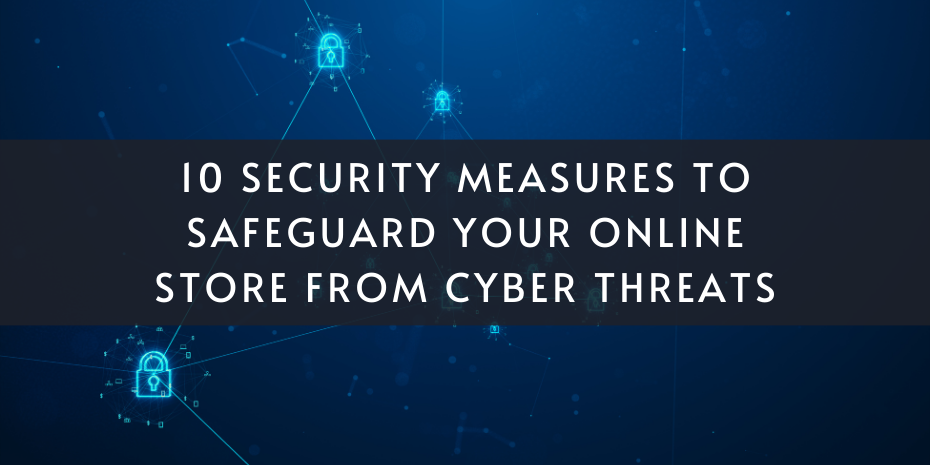Did you know that cyber threats are constantly evolving and posing a significant risk to online stores? With the increasing number of online transactions and the valuable data stored within e-commerce platforms, it's crucial for businesses to implement robust security measures to safeguard their online stores from potential cyber attacks. In this article, we will discuss 10 essential security measures that can help protect your online store from cyber threats, ensuring the safety of your customers' data and the reputation of your business.
1. Install SSL Certificate
Implementing an SSL certificate is crucial for securing the data transmission between your online store and customers. This certificate encrypts the data exchanged between the web server and the user's browser, preventing unauthorized access to sensitive information such as credit card details and personal data. To obtain an SSL certificate, you can purchase one from a reputable Certificate Authority (CA) or use free options such as Let's Encrypt.
By implementing SSL, you build trust with your customers and protect their information from potential cyber threats. A real-life example of the importance of SSL certification can be seen in the e-commerce industry, where customers are more likely to make purchases on websites with the padlock symbol indicating a secure connection. This simple step can significantly enhance the security of your online store and enhance the overall customer experience.
2. Use Strong Passwords
Implementing complex password policies is crucial to prevent unauthorized access. Keywords like "strong passwords" and "multi-factor authentication" should be included. To enforce these policies, require employees and customers to create passwords with a mix of uppercase and lowercase letters, numbers, and special characters. Regularly update passwords and avoid using personal information or easily guessable combinations.
Training sessions on creating strong passwords can help employees understand the importance of secure login credentials. Real-life examples such as the data breach at Equifax, which exposed passwords stored in plaintext, underscore the need for robust password policies. Utilize password managers to securely store and generate complex passwords, reducing the risk of unauthorized access.
Multi-factor authentication adds an extra layer of security by requiring additional verification beyond just a password. Real-life case studies, like the cyber attack on Yahoo that compromised billions of user accounts, emphasize the effectiveness of multi-factor authentication in thwarting unauthorized access attempts. Encourage the use of biometric verification or one-time passcodes for added security.
3. Regularly Update Software
Keeping your online store's software and plugins up to date is crucial for ensuring the security of your ecommerce platform. By regularly updating your software, you can patch any security vulnerabilities that may be present in older versions. This will help prevent potential cyber attacks and protect your customers' sensitive data.
One actionable tip is to set up automatic updates for your ecommerce platform and plugins. This way, you can ensure that you are always running the latest versions without having to manually update each component. Additionally, regularly checking for updates and applying them promptly can help minimize the risk of security breaches.
A real-life example of the importance of updating software is the 2017 Equifax data breach, which exposed the personal information of approximately 147 million people. The breach was attributed to a vulnerability in a software framework that Equifax failed to patch in a timely manner. By keeping your online store's software up to date, you can avoid falling victim to similar security incidents and protect your reputation as a trustworthy ecommerce business.
4. Implement Two-Factor Authentication
Implementing a two-factor authentication system can significantly enhance the security of user accounts. By requiring users to provide two forms of identification, such as a password and a unique code sent to their mobile device, the risk of unauthorized access is greatly reduced. This additional layer of security makes it harder for hackers to breach accounts, as they would need access to both the user's password and their secondary form of identification.
To ensure a seamless user experience, it is essential to choose user-friendly two-factor authentication methods. Options such as SMS codes, email verification, or biometric authentication can offer a balance between security and convenience. Providing clear instructions to users on how to set up and use two-factor authentication can help them understand the importance of this additional security measure and encourage compliance.
Real-life examples of successful implementation of two-factor authentication can be seen in popular online platforms such as Google, Facebook, and banking institutions. These companies have seen a significant decrease in unauthorized access and data breaches since implementing two-factor authentication. By following their lead and incorporating similar security measures, organizations can better protect their users' accounts and sensitive information.
5. Monitor Website Traffic
Implementing security tools such as intrusion detection systems (IDS) and web application firewalls (WAF) can help monitor website traffic for any suspicious activities or potential cyber threats. These tools can analyze incoming and outgoing network traffic to detect and prevent malicious activities, such as SQL injection attacks or cross-site scripting.
Regularly reviewing logs and reports generated by these security tools can provide valuable insights into the types of threats targeting your website. By monitoring traffic patterns and identifying any anomalies, you can proactively take steps to mitigate risks and strengthen your website's security posture. For example, if a sudden spike in traffic is detected from a specific IP address, it could indicate a potential DDoS attack, prompting you to take immediate action to block the malicious traffic.
One real-life example of the importance of monitoring website traffic for suspicious activities is the Equifax data breach in 2017. Hackers exploited a vulnerability in the company's website to gain access to sensitive customer information, resulting in one of the largest data breaches in history. With the right security tools in place, Equifax could have potentially detected and prevented the breach by monitoring their website traffic for any unusual or unauthorized access attempts.
6. Backup Data Regularly
Regularly backing up important data is crucial to safeguard against potential cyber attacks or data breaches. Implement a robust backup plan using keywords like encryption, cloud storage, and automated backups. Utilize secure and encrypted storage solutions to protect sensitive information from unauthorized access.
For example, in 2017, the ransomware attack known as WannaCry affected organizations worldwide, encrypting data and demanding payment for decryption. Companies with recent backups were able to restore their systems without succumbing to the hackers' demands. By consistently backing up data and testing restoration processes, organizations can minimize the impact of cyber threats and ensure business continuity.
7. Train Employees on Security
It is crucial to educate employees on best security practices to mitigate human errors that may result in security breaches. Implementing strategies such as regular security awareness training sessions, emphasizing the importance of strong passwords and multi-factor authentication, and promoting a culture of vigilance among staff can significantly reduce the likelihood of breaches.
Encouraging employees to avoid clicking on suspicious links or emails, verifying the authenticity of requests for sensitive information, and adhering to established protocols for data handling are essential steps in strengthening security measures. Utilizing examples of successful phishing attacks or data breaches in training sessions can highlight the potential risks of non-compliance and emphasize the importance of following security protocols.
Incorporating real-life case studies of companies that have suffered from security breaches due to human errors can serve as cautionary tales and reinforce the need for vigilance. By creating a well-rounded security awareness program that not only educates employees on best practices but also demonstrates the consequences of non-compliance, organizations can empower their staff to actively contribute to a secure work environment.
8. Secure Payment Gateways
When selecting a payment gateway for your business, prioritize security by choosing providers that comply with industry standards such as PCI DSS (Payment Card Industry Data Security Standard). Look for gateways that offer tokenization, encryption, and fraud detection tools to safeguard customer payment information.
A good example of a secure payment gateway is PayPal, which is known for its robust security measures and adherence to PCI DSS requirements. With features like two-factor authentication and real-time monitoring, PayPal ensures that customer data is protected from cyber threats and unauthorized access.
In addition to PayPal, other reputable payment gateways like Stripe and Authorize.Net also offer top-notch security features to prevent data breaches and credit card fraud. By partnering with providers that prioritize security and comply with industry regulations, businesses can build trust with customers and safeguard sensitive payment information effectively.
9. Limit Access to Data
Implement role-based access control (RBAC) to limit access to sensitive data based on job responsibilities. By assigning specific roles to employees and granting them access only to the information necessary for their tasks, you can minimize the risk of unauthorized access. Regularly review and update access permissions to ensure they align with current job functions.
Utilize encryption techniques to protect sensitive data both at rest and in transit. By encrypting data before storing it and utilizing secure communication protocols for transferring information, you can add an additional layer of protection against data exposure. Implement policies that mandate encryption for all sensitive data to prevent unauthorized access.
Train employees on data security best practices to reduce the likelihood of human error leading to data breaches. Educate staff on the importance of safeguarding sensitive information, recognizing phishing attempts, and following proper data handling procedures. Conduct regular security awareness sessions and simulations to reinforce good habits and keep security top of mind.
10. Conduct Security Audits
Regularly conducting security audits and penetration testing is crucial to identify and address potential security vulnerabilities within your systems. By utilizing tools like vulnerability scanners, penetration testing frameworks, and manual testing techniques, organizations can proactively assess their systems and applications for weaknesses. This allows for the timely remediation of any discovered vulnerabilities before malicious attackers can exploit them.
One actionable tip is to establish a comprehensive security audit schedule that aligns with best practices and regulatory requirements. This ensures that all relevant systems, networks, and applications undergo regular security assessments. Additionally, investing in skilled cybersecurity professionals or engaging with third-party security firms can provide expertise and resources to conduct thorough audits and penetration tests.
A real-life example of the importance of security audits and penetration testing is the Equifax data breach in 2017. The breach occurred due to a failure to patch a known vulnerability in the Apache Struts framework, leading to the compromise of sensitive personal information of over 147 million individuals. Regular security audits and penetration testing could have potentially identified and remediated this vulnerability before it was exploited by threat actors.





